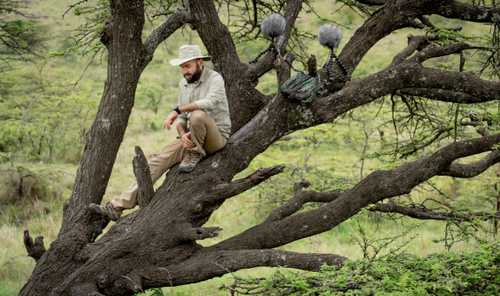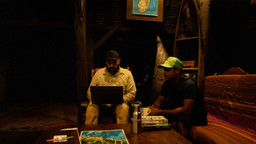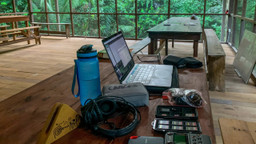
Here’s a question I receive quite often: how do you manage to listen to all the recordings you capture? Let me try to answer, but first here’s a little background.
Long-form field recording
I’m a big fan of unattended long-form recording. I want to capture the sounds of nature and wildlife as they happen over many day/night cycles, in the same physical location. I want the ecosystems I record to have a chance to get back to their natural state once I’ve been there. I want to cover a variety of weather, activity levels and interactions.
In most locations I’ve recorded, capturing clean natural sound free from anthropophony has been a challenge. Sometimes I need to record for many hours to capture a few minutes of clean audio.
The advantages of unattended recording are clear, but there are also downsides. Without going into too much detail (I will touch on this in a future article), there is a much higher risk that my equipment gets damaged or destroyed while out in the field – by temperature, weather, animals, people etc.
Dynamics evolve over time, so a calm subtle ambience during daytime can turn into a chaotic scene at night; thunderstorms will almost certainly overload mics and preamps; animals getting too close can also be an issue.
Lastly, and the focus of this essay, you will quickly end up with hundreds or even thousands of hours of recordings that become an issue to catalogue and curate properly.
In the field

Sound recording curation starts in the field. I always bring a laptop with me even on my most remote expeditions. This can be a risky proposition, but I wouldn’t be able to do my work properly without checking my recordings once I collect the rigs. I also don’t trust automated processes and devices with copying and backing up data.
💻 More on data management in the field in this blog post.
One important caveat here is I don’t delete anything in the field. I bring enough portable drives so I don’t need to make this sort of decision until I get back in the studio and I can listen on a good playback system. That’s because even in the most hopelessly poor recording there might be something worth salvaging.
In the studio
My mindset in the studio is never a matter of catching up versus falling behind. I think that would be a losing game in my line of work. First, because I’m on recording expeditions for more than 4 months every year, and secondly because I keep going back to the same recordings but looking for different things.
Once I return to the studio, I do a quick listening/looking pass to catalogue everything. I use Adobe Audition and Izotope RX, and I rely on my ears as much as on my eyes at this stage. I switch between waveform and spectrogram view, and I listen out for interesting and noteworthy elements that I can drop markers for.
I don’t do any editing or processing on the original files. At this point I’m more interested in getting a good feel for what I’ve captured on the trip. Having said that, I do take notes in a separate document. I could also add metadata to the files but I’m not 100% convinced it’s the best approach, as it can mess up certain things by pushing file size over 4TB.
Use cases

Once I have a rough overview of what recordings I’ve captured on the trip, I’m ready to listen in more detail and to export audio for specific uses. The first of these is long-form soundscape for my YouTube channel. It usually takes me anywhere between a few hours and a few days to put together one of these, but that goes beyond selecting and editing the audio, into creating the visuals and writing the description.
If I’m contracted to go on a recording expedition, or if I get any sponsorships, I will try to prepare and send the deliverables as soon as possible once I’m back in the studio. There are no rules here as every client or sponsor will have their own schedules and requirements. While I’m usually fairly optimistic, I like to give myself at least a few weeks after the trip so I can work on deliverables in a relaxed manner (while catching up on sleep and recovering from any injuries/illnesses picked up).
Sound effects libraries require much more listening, editing and mastering. Some of them take years of on and off work. Even the easier ones end up taking a few months. I usually have a list of elements I need, like a variety of times of day/night, weather, dynamic ranges, intensities, etc. for a nature sounds library. Once I’ve made a rough selection and exported a number of potential tracks I’m happy with, I check everything very carefully in RX and clean up any unwanted elements as long as this doesn’t affect the recordings too much.
I also release albums for listening, I compose music with my sound recordings, and I use my recordings in video games, films and other media. Each of these requires a different mindset and more listening. And each of these offers another exciting opportunity for me to dive into my recordings and to enjoy listening to them.
Listening

To conclude, I want to make two very important points related to listening.
The first one is that it should be fun. Having to listen to hundreds of hours of recordings should not feel like a chore. If it does, you may have to rethink your approach to sound recording. There’s nothing wrong with recording only while being present and limiting the amount of recordings you bring back from an expedition. That might even improve your skills and make you think more deliberately about the process of recording. It will certainly create less work for you in the studio. For me, listening to extremely long recordings is as much fun as it is recording them, and I do it every day. It’s my job to do it, and I enjoy it so much that it never feels tedious.
Secondly, recording soundscapes is only half of the work. Listening to your own recordings is where a lot of learning takes place. If you skip this, you run the risk of making the same mistakes over and over. You may not even develop good listening skills which are very useful in the field. Once you’ve done your listening work in the field and in the studio, you will be much better equipped to discern between a good recording and a mediocre one. You will be able to admit to yourself that a recording you’ve made might not be as good as you hoped it would be. You will be able to select the absolute best recordings you’ve made, and to only show these instead of uploading a mixed bag of various quality levels.
So how do I manage to listen to all the recordings I capture?
I actually don’t anymore, because I have too much work to do. I listen to the right amount of recordings that allows me to do my work well. That’s sometimes 50% of what I capture on a trip, and sometimes more. What’s certain is that as time passes, I go back and listen to more of my recordings, and to some of them more than once.
Eventually I will get to all of them, but for now I don’t feel like I’m missing out, and the growing number of folders in my catalogue is a source of happiness instead of being a source of stress.
George Vlad is a sound recordist, photographer, and expedition leader who specialises in recording remote soundscapes, rare wildlife, and extreme environments. Fore more information check out his website and listen to his work on his YouTube channel.
Photos courtesy of George Vlad
Earth.fm is a completely free streaming service of 1000+ nature sounds from around the world, offering natural soundscapes and guided meditations for people who wish to listen to nature, relax, and become more connected. Launched in 2022, Earth.fm is a non-profit and a 1% for the Planet Environmental Partner.
Check out our recordings of nature ambience from sound recordists and artists spanning the globe, our thematic playlists of immersive soundscapes and our Wind Is the Original Radio podcast.
You can join the Earth.fm family by signing up for our newsletter of weekly inspiration for your precious ears, or become a member to enjoy the extra Earth.fm features and goodies and support us on our mission.
Subscription fees contribute to growing our library of authentic nature sounds, research into topics like noise pollution and the connection between nature and mental wellbeing, as well as funding grants that support emerging nature sound recordists from underprivileged communities.
